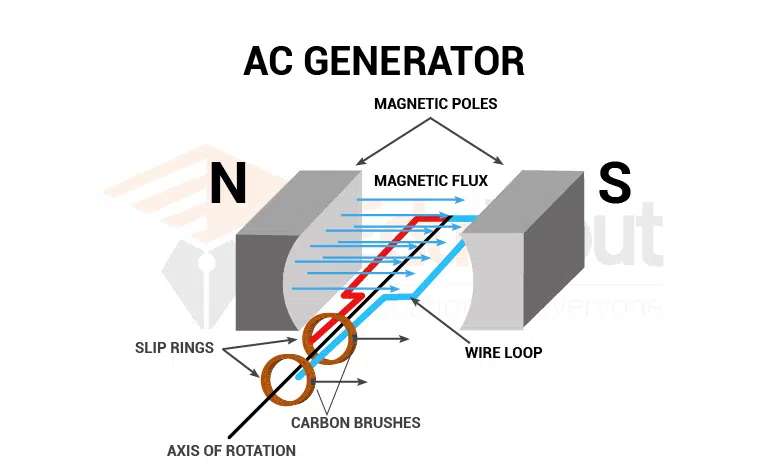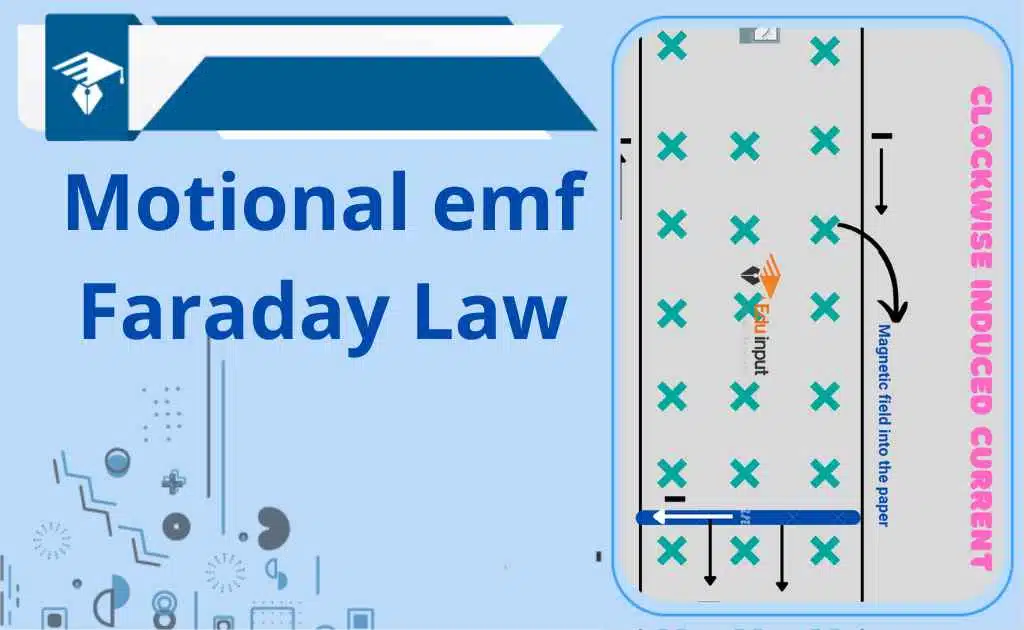Alternating Current Generator-Construction, And Working
An alternating current generator is a device that is used to produce current electricity. An alternating current generator is a device that produces an electric potential difference.
Alternating current generator
It is a device that converts mechanical energy into electrical energy.
Alternating current generator Principle:
The principle of alternating current generators is based on Faraday’s law of electromagnetic induction. When a coil is rotated in a magnetic field magnetic flux through the coil changes and an emf has induced in the coil.
Alternating current generator Construction
It consists of the following major parts:

Armature
A number of coils are wound around an iron cylinder which is rotated in the magnetic field.
Slip rings
The ends of the coil are attached with the metal rings R and R/ called the Slip Rings. These rings are concentric with the axis of the loop and rotate with it.
Carbon Brushes
The slip rings RR’ slide against stationary carbon brushes connected with an external circuit.
Alternating current generator Working
A rectangular loop of wire of area A is placed in a uniform magnetic field B. The loop is rotated about the z-axis through its center at constant angular velocity. To calculate the induced emf in the loop consider when the coil is rotating anti-clockwise. The vertical side ab is moving with velocity v in the magnetic field B if the angle between v and B is θ
ԑab =v BL sinθ
It should be noted that the direction of the induced current in the wire ab is the same as that of the force F experienced by the positive charge in the wire from top to bottom. Similarly current through the side cd is
ԑcd =v BL sinθ
Now the direction of the induced current is from the bottom to the top. The emf through the sides bc and da is zero because these sides are parallel and anti-parallel to the field.
So the total emf through the loop is
ԑ=ԑab+ԑcd
ԑ= v BL sin θ +v BL sin θ
ԑ=2vBL sin θ
For a coil of N turns we have
ԑ=N v BL sin θ
ԑ=2N(r) ωBL Sin θ
ԑ=N ω (2rL)B sin θ
Let L be the length and 2r be the width of the coil. Then the area of the coil will be
A=2rL
ԑ=N ω AB Sin θ
θ= ω t
ԑ=N ω AB Sin (ω t)
The equation shows that the induced emf varies sinusoidally with time. It will be maximum for Sin θ (ω t) =1 so
ԑo=N ω AB
Where ԑo is the maximum induced emf. The equation can be written as
By Ohms law
ԑ=IR
I=ԑ/R
I= ԑo Sin (ω t)/r= ԑo/R*Sin (ω t)
The angular speed ω of the coil is related to its frequency f as
ω=2π f
ԑ= ԑo Sin (2 π ft)
I=Io Sin (2 π ft)
The graph between the Current and angle
When the angle between v and b is 0 the plane of the loop is perpendicular to B and so the current is zero.
When θ=900 or 3π/2 radius the loop is parallel to B and the current is maximum.
When θ=1800 or π radius the loop is again perpendicular to B so the current is zero.
When θ=2700 or 3π/2 radius the loop is parallel to B current is maximum.
When θ=3600 or 2π radius current is again zero.
It should be noted that the current increase twice in a cycle but in the opposite direction. Thus the current alternate in direction once in one cycle. Such a current is called an alternating current.
Role of Armature
In actual practice, a number of coils are wound around an iron cylinder which is rotated in the magnetic field. This assembly is called Armature.
The magnetic field is usually provided by an electromagnet. The armature is rotated by a fuel engine or a turbine run by a waterfall. In some commercial generators, the field magnet is rotated around a stationary armature.
Related FAQs
What is an alternating current generator?
An alternating current (AC) generator is a device that converts mechanical energy into electrical energy, producing an alternating current as its output.
How does an AC generator work?
An AC generator works by rotating a coil of wire within a magnetic field. This motion induces an alternating current in the coil due to the changing magnetic flux.
What is the structure of an AC generator?
An AC generator consists of a rotor (rotating part) with coils of wire, a stator (stationary part) with magnets or electromagnets, and a system to convert the produced AC to usable power.
What is the difference between an AC generator and a DC generator?
An AC generator produces alternating current, where the direction of current periodically reverses. A DC generator produces direct current, where the current flows in one direction. The working principles and internal structures of these generators differ due to the type of current they produce.







Leave a Reply